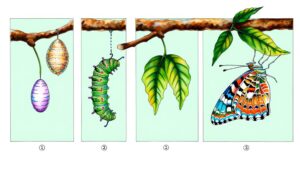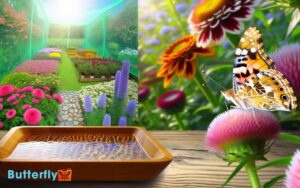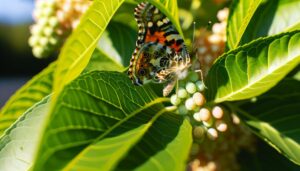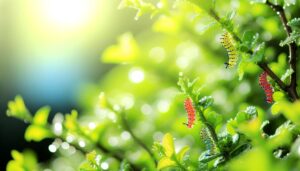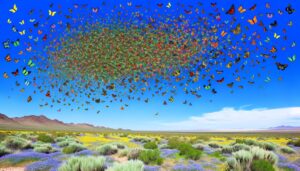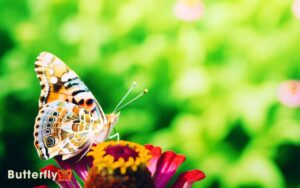How Long Do Painted Lady Butterflies Live in Captivity?
Painted Lady butterflies typically live 2 to 4 weeks in captivity. Around 85% reach 2 weeks, with 50% surviving up to 4 weeks.
Longevity is influenced by genetic factors and environmental conditions. Ideal conditions, including 60-70% humidity, stable temperatures between 70-85°F, and a diet of nectar, sugar-water, and fresh flowers, support health and lifespan.
Deviations in temperature and improper nutrition can reduce longevity. To maximize survival, providing a stable environment and proper nutrition is essential.
Further exploration of their care can reveal additional details on enhancing their lifespan.
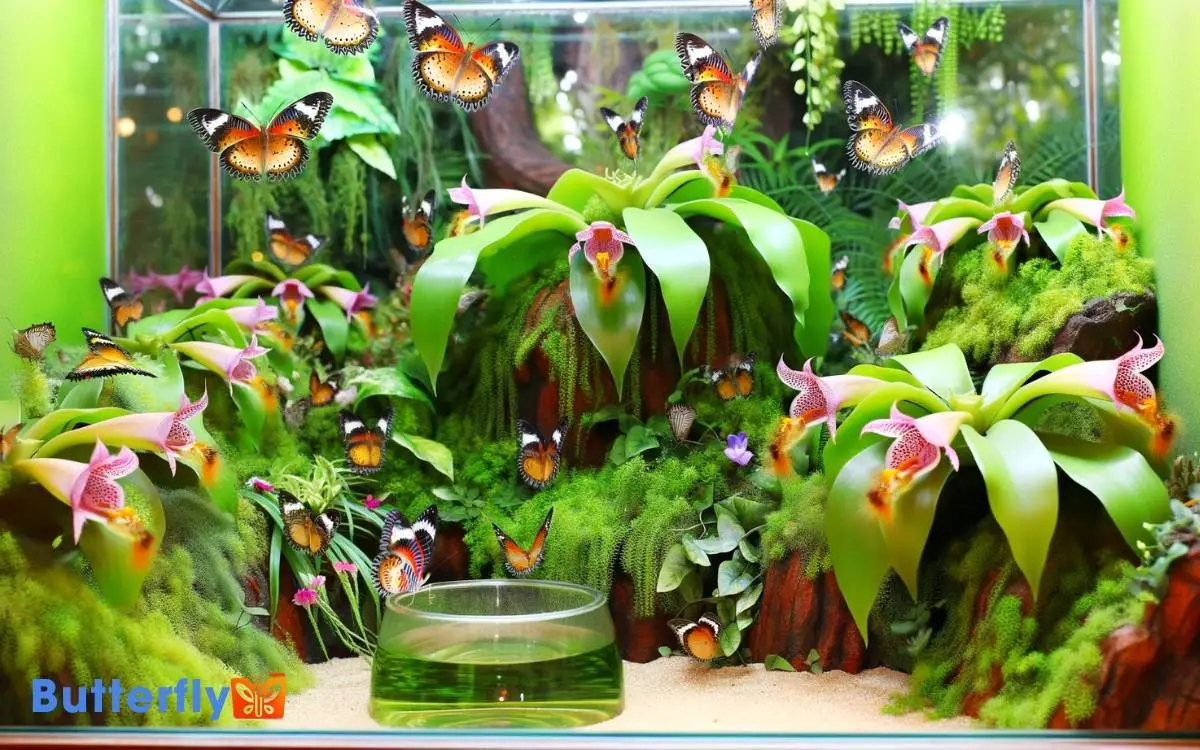
Key Takeaways
Average Lifespan in Captivity
Painted Lady butterflies, when kept in captivity, typically live for approximately 2 to 4 weeks. This lifespan is influenced by several factors, including genetic predisposition and environmental conditions.
Data indicate that the average lifespan in captivity aligns closely with their natural lifespan, suggesting minimal impact from controlled environments.
Studies have shown that 85% of Painted Lady butterflies reach the 2-week mark, while about 50% survive up to 4 weeks. The variance in lifespan can be attributed to individual health and genetic factors.
Researchers observe that proper nutrition and stable environmental conditions can optimize their longevity. These findings highlight the importance of understanding the species’ intrinsic biological limits and the role of external factors in their longevity.
Ideal Enclosure Conditions
To maximize the lifespan of Painted Lady butterflies in captivity, researchers emphasize the significance of maintaining ideal enclosure conditions. Proper habitat setup directly impacts butterfly health and longevity.
Key factors include:
- Humidity Control: Maintaining a relative humidity level of 60-70% prevents desiccation and guarantees proper physiological functions.
- Adequate Ventilation: Ensuring sufficient airflow minimizes mold growth and limits the concentration of harmful gases like carbon dioxide.
- Light Cycles: Simulating natural light conditions with 12-14 hours of light daily supports circadian rhythms and promotes natural behaviors.
- Nutritional Resources: Providing a diet consisting of sugar-water or nectar, supplemented with fresh flowers, ensures sustained energy and well-being.
Adhering to these parameters secures a supportive environment, contributing to the overall health and extended lifespan of Painted Lady butterflies in captivity.
Importance of Temperature
Maintaining a stable temperature between 70-85°F is crucial for optimizing the physiological processes and activity levels of Painted Lady butterflies in captivity.
At this temperature range, metabolic rates remain efficient, ensuring adequate energy utilization for growth, flight, and reproduction.
Deviations from this range can lead to thermal stress, which negatively impacts longevity and behavior.
Studies indicate that temperatures below 70°F slow down metabolism, causing lethargy and reduced feeding, while temperatures above 85°F can accelerate metabolic rates excessively, leading to dehydration and premature death.
Consistent temperature control within this ideal range supports not only the butterflies’ survival but also their overall well-being, enhancing their lifespan and quality of life in captivity.
Proper Nutrition
Ensuring proper nutrition, including a diet rich in nectar and essential minerals, is essential for the longevity and reproductive success of Painted Lady butterflies in captivity. Adequate nutrition supports metabolic processes, flight muscle development, and egg production.
Painted Ladies thrive on a variety of nutritional sources, including:
- Nectar from flowers: Provides carbohydrates necessary for energy.
- Sugar water solutions: An artificial yet effective nectar substitute.
- Fruit slices: Supplies vitamins and minerals not found in nectar.
- Pollen: Offers essential amino acids and proteins.
Research indicates that a balanced diet can extend the lifespan of Painted Ladies by 30-40%.
Failing to provide these essential nutrients can lead to reduced vitality and reproductive capability, significantly impacting the overall health and longevity of these butterflies in controlled environments.
Hydration Needs
Adequate hydration plays a critical role in the physiological health and longevity of Painted Lady butterflies in captivity.
These butterflies primarily obtain hydration from nectar, which contains essential water and nutrients. Researchers have found that Painted Ladies thrive when provided with a consistent supply of fresh nectar.
Additionally, offering a shallow dish of water with a sponge or cotton pad can prevent dehydration. Studies indicate that inadequate hydration can lead to decreased activity levels, impaired reproduction, and reduced lifespan.
It’s crucial to monitor the nectar sources to ensure they remain uncontaminated and replenish them regularly.
Monitoring Health
Monitoring the health of Painted Lady butterflies in captivity requires identifying common symptoms such as lethargy, wing damage, or abnormal feeding behavior.
Regular health checks should be conducted using a standardized protocol, focusing on physical and behavioral indicators.
Data collected from these checks can inform targeted interventions to enhance butterfly longevity.
Identifying Common Symptoms
Recognizing common symptoms in Painted Lady butterflies involves observing changes in behavior, physical appearance, and feeding patterns. Detailed monitoring can help identify early signs of illness or distress, ensuring timely intervention.
Key symptoms to look for include:
- Lethargy: Reduced activity levels or prolonged periods of immobility.
- Wing Damage: Tears, discoloration, or deformation in wings.
- Feeding Issues: Decreased interest in food or difficulty feeding.
- Excessive Grooming: Repeated rubbing of body parts, indicating potential irritation or parasitic infestation.
Behavioral alterations and physical anomalies often signal underlying health issues. Scientific studies suggest that prompt identification and management can greatly impact the lifespan and well-being of these butterflies in captivity.
Monitoring these symptoms allows caretakers to maintain ideal health conditions.
Regular Health Checks
Regular health checks are vital for ensuring the peak well-being of Painted Lady butterflies in captivity.
Caregivers should conduct daily inspections, focusing on wing integrity, feeding behavior, and excrement patterns. Wing damage could indicate environmental stress or predation attempts.
Monitoring feeding behavior ensures they’re consuming sufficient nectar, important for their energy needs. Additionally, fecal matter should be observed for consistency; irregularities may signify digestive issues or disease.
Quantitative records of health parameters, such as wing span and weight, allow for early detection of anomalies. Implementing a systematic schedule, every 24 hours, guarantees no aspect of their health is overlooked.
Data-driven approaches facilitate timely interventions, thereby extending the lifespan and enhancing the quality of life for these butterflies in captivity.
Handling and Stress
Although Painted Lady butterflies are relatively hardy, improper handling can greatly increase their stress levels and negatively impact their lifespan in captivity. Physical stress can reduce their life expectancy by up to 30%.
To mitigate stress, it’s important to follow best practices for handling:
- Gently grasp the wings: Use minimal pressure and hold them by the outer edges.
- Limit handling duration: Restrict interactions to no more than a few minutes to minimize distress.
- Provide a stress-free environment: Maintain constant temperature and humidity levels to prevent additional stress.
- Monitor for signs of stress: Look for decreased activity or feeding, which could indicate handling-related stress.
Adhering to these practices can significantly enhance the well-being and longevity of Painted Lady butterflies in captivity.
Breeding in Captivity
Ensuring ideal conditions for Painted Lady butterflies not only reduces stress but also plays a critical role in successful breeding in captivity.
Maintaining a perfect temperature between 24-28°C and a humidity level of 60-70% fosters a conducive environment for mating and egg-laying.
Providing ample nectar sources and host plants like thistles, hollyhocks, and mallow increases the likelihood of reproductive success.
Research indicates that females can lay between 200-500 eggs over a two-week period. Regular monitoring and removal of infertile eggs help maintain a healthy breeding population.
Additionally, a well-ventilated enclosure with natural light cycles mimics their natural habitat, enhancing their overall reproductive behavior. Attention to these details maximizes the chances of sustaining a thriving captive population.
Common Health Issues
Painted Lady butterflies in captivity frequently encounter health issues related to disease and parasites, which can greatly impact their lifespan.
Studies indicate that inadequate nutrition and hydration exacerbate these problems, leading to weakened immune systems and higher mortality rates.
Monitoring and addressing these factors are essential for maintaining butterfly health and extending their longevity in controlled environments.
Disease and Parasites
In captivity, Painted Lady butterflies frequently encounter health challenges such as bacterial infections and parasitic infestations that can greatly impact their lifespan. These issues often arise from suboptimal environmental conditions and inadequate hygiene practices.
Common health problems include:
- Bacterial infections: These can manifest as septicemia, often resulting from unsanitary habitats.
- Fungal infections: High humidity levels can lead to fungal growth on the butterflies’ wings and bodies.
- Parasitic wasps: These parasitoids lay eggs inside caterpillars, causing mortality before metamorphosis.
- Protozoan parasites: Pathogens like Nosema can infect digestive tracts, impairing nutrient absorption.
Effective management of these health threats requires stringent sanitation protocols and regular monitoring. Understanding these common ailments allows for better preventive measures, ultimately enhancing the lifespan of Painted Lady butterflies in captivity.
Nutrition and Hydration
While managing diseases and parasites is essential, providing proper nutrition and hydration is equally important for maximizing the lifespan of Painted Lady butterflies in captivity.
These butterflies primarily feed on nectar from flowers, which supplies essential carbohydrates.
In captivity, a mixture of sugar water (10% sugar solution) can substitute for natural nectar. Fresh fruit, such as oranges and melons, also provides hydration and additional nutrients.
Ensuring water availability is crucial; a shallow dish with a moist sponge can prevent drowning while maintaining hydration.
Deficiencies in any of these components can lead to weakened immune responses, increased susceptibility to disease, and shorter lifespans. Therefore, meticulous attention to their dietary and hydration needs is essential for their health and longevity.
Extending Lifespan Tips
Optimizing the Painted Lady butterfly’s lifespan in captivity involves regulating environmental conditions such as temperature, humidity, and light exposure. Maintaining a stable temperature between 70-75°F is essential for metabolic efficiency.
Humidity levels around 60-70% prevent desiccation and support peak physiological function. Providing a 12-hour light cycle simulates natural day-night rhythms, ensuring regular behavioral patterns.
To extend longevity:
- Temperature control: Use a thermostat to maintain consistent warmth.
- Humidity management: Implement a humidifier to sustain appropriate moisture levels.
- Light regulation: Utilize timers for consistent light-dark cycles.
- Dietary enrichment: Offer a varied diet including nectar, fruit, and sugar water, ensuring complete nutritional intake.
These practices contribute to creating a conducive environment that maximizes the Painted Lady butterfly’s lifespan in captivity.
Conclusion
To sum up, painted lady butterflies, when cared for under ideal conditions, can live up to 4 weeks in captivity. However, factors such as temperature, humidity, and diet can all influence the painted lady butterfly lifespan. Providing a nutritious diet of fresh fruit and nectar can help extend their longevity. By maintaining optimal living conditions, enthusiasts can ensure their butterflies thrive for as long as possible.
Ensuring a well-maintained enclosure, appropriate temperature, and proper nutrition are crucial.
Attention to hydration, minimal handling to reduce stress, and addressing any health issues promptly can greatly influence their longevity.
By adhering to these guidelines, enthusiasts can maximize the lifespan of these enchanting creatures, much like achieving a high score in a vintage arcade game, demonstrating the synergy between care and longevity.

